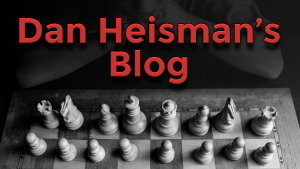Q&A with Coach Heisman Sep 14, 2012
"Never bring a queen out too soon"
But what is too soon? What is too anything, for that matter? How does it help someone to tell them not to bring out their queen too soon? If it is bad, it's too soon, and if it's good it's not too soon! 
Let's take two common opening positions. The first is the rare Center Game:
Now let's just change one set of moves, inserting 2.Nf3 Nc6, and getting into the Scotch Opening:
OK, now what are the main 4th moves for Black?
--------
1. 4...Nf6 developing the knight and attacking the e-pawn
2. 4...Bc5 developing the bishop and attacking the white knight, and
3. 4...Qh4 developing the queen and attacking the e-pawn
-----------
But why doesn't Black lure the white queen to the center with 4...Nxd4 5.Qxd4? After all, that looks a lot like the Center Game, which is not the most popular line for White, so shouldn't this variation in the Scotch also be good for Black? Turns out it is not...
If you understand why the first Center Game sequence is not so great for White but the final "Scotch" sequence is good for White, even though they look similar, you are going a long way toward understanding when early queen sorties are questionable:
In the Center Game, Black takes a piece which was dormant, the queen's knight, and attacks the white queen with 3...Nc6. The queen is forced to move. But in the final sequence - the Scotch with 4...Nxd4 5.Qxd4 - the black queen knight is already traded off. In the Scotch, the white queen on d4 looks vulnerable, as it was in the Center Game, but it's not. If Black decides to blindly attack it with 5...c5, then the black d-pawn becomes backward on the semi-open d-file, and the pawn on c5 may be doing even less than it was on c7 (at best about the same), while the queen "retreat" from d4 by, say, 6.Qd3 still leaves the white queen active.
Bottom line: strong players shun the Center Game for White, yet also avoid 4...Nxd4 for Black in the Scotch.
This was just one of the many questions on today's show. The prize for the most "open-ended" question was "What is a good thought process for finding a move?" It's a great question and we could spend 24 hours just on that one (I have written a book or two, like The Improving Chess Thinker, just on that subject). Unfortunately, for a TV show we only have a few minutes to cover each question. I tried to summarize by stating that there is no single correct thought process, but in analytical positions the following five ingredients are helpful:
-----------
1. What are ALL the things my opponent is trying to do?
2. What are ALL the things I might do which would be beneficial?
3. Which moves address the aspects of #1 and #2 and are thus candidates?
4. Which of the moves in #3 are safe, i.e. cannot be defeated by an opponent's check, capture, or threat in response that would win material or checkmate by force? If the move is not safe, am I willing to sacrifice?
5. Among the moves that pass step 4, which one is the best I can find in a reasonable amount of time?
Hint: When good players think, they do steps 1-4 very quickly and accurately and spend most of their time on #5. So if a strong player is thinking for 10 minutes, likely 9 are spent on #5. For more on why there is no single correct thinking process, see the recent controversial book "Move First, Think Later" by Willy Hendriks.
As noted in my previous show notes, one of the best ways to learn things is to analyze with your opponents and any strong players you can find. Also, you can learn all aspects of chess when you play over instructive annotated games (only read the parts you find fun). There is a big difference between books written for instruction, like McDonald's The Art of Logical Chess Thinking and game books for other purposes, like Karpov's Best Games. Yet if you are strong enough (1800+ USCF/FIDE), then even books written for non-instructive purposes can be instructive. And I forgot to mention that Chess.com has the most instructional videos - just pull-down menu "Learn" and go to Video Lessons! 

One important thing that several viewers learned is that if you want to restrict your tactics training to a certain level (rating range), the Chess.com Tactics Trainer has the ability to do this. Thanks to David Pruess for showing the viewers who were on the channel how to do this. I learned something, too!
This issue came up because I noted that most intermediates are not nearly as good at basic tactics as they think they are, just because they can solve the problems easily. Yet when I play them in speed chess, I can recognize the tactical issues much more quickly and accurately. The goal in basic tactics study is recognition, not solving ability. And once you recognize basic tactics much better, then you can solve intermediate and difficult problems better, too, since many of these involve permutations, or at least aspects, of one or more basic safety patterns.
One of the tactical motifs we discussed was the underrated, and commonly occurring, Removal of the Guard. If I recall correctly from work on my book Back to Basics: Tactics, this was the 3rd or 4th most common motif missed in actual games, behind Double Attacks/Threats and Pins.
Finally, I would like to thank our neighbor's dog, Cherie, for a guest appearance on the show. Cherie was lonely and invaded my home studio, so I made her a TV star. It will probably be her only appearance (we were just dog-sitting), but it was a memorable one. Dog acts usually boost TV ratings. 



